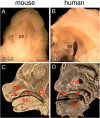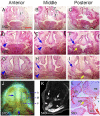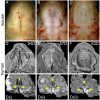Differences in Oral Structure and Tissue Interactions during Mouse vs. Human Palatogenesis: Implications for the Translation of Findings from Mice
- PMID: 28360863
- PMCID: PMC5350148
- DOI: 10.3389/fphys.2017.00154
Differences in Oral Structure and Tissue Interactions during Mouse vs. Human Palatogenesis: Implications for the Translation of Findings from Mice
Abstract
Clefting of the secondary palate is one of the most common human birth defects and results from failure of the palatal shelves to fuse during embryonic development. Palatogenesis is traditionally considered to be a highly conserved developmental process among mammalian species. However, cleft palate phenotypes in humans are considerably more variable than those seen in mice, the most common animal model for studying palatal development and pathogenesis of cleft palate. In this investigation, we utilized macroscopic observations, histology and 3D imaging techniques to directly compare palate morphology and the oral-nasal cavity during palate closure in mouse embryos and human conceptuses. We showed that mouse and human palates display distinct morphologies attributable to the structural differences of the oral-nasal cavity. We further showed that the palatal shelves interact differently with the primary palate and nasal septum in the hard palate region and with pharyngeal walls in the soft palate region during palate closure in mice and humans. Knowledge of these morphological differences is important for improved translation of findings in mouse models of human cleft lip/palate and, as such, should ultimately enhance our understanding of human palatal morphogenesis and the pathogenesis of cleft lip/palate in humans.
Keywords: cleft palate; hard palate; human development; mouse models; nasal septum; palatogenesis; soft palate; uvula.
Figures






Similar articles
-
An in vitro mouse model of cleft palate: defining a critical intershelf distance necessary for palatal clefting.Plast Reconstr Surg. 2001 Aug;108(2):403-10. doi: 10.1097/00006534-200108000-00019. Plast Reconstr Surg. 2001. PMID: 11496182
-
Closing the Gap: Mouse Models to Study Adhesion in Secondary Palatogenesis.J Dent Res. 2017 Oct;96(11):1210-1220. doi: 10.1177/0022034517726284. Epub 2017 Aug 17. J Dent Res. 2017. PMID: 28817360 Free PMC article. Review.
-
Observation of the Epithelial Cell Behavior in the Nasal Septum During Primary Palate Closure in Mice.Front Physiol. 2020 Oct 2;11:538835. doi: 10.3389/fphys.2020.538835. eCollection 2020. Front Physiol. 2020. PMID: 33123019 Free PMC article.
-
Tbx22 expressions during palatal development in fetuses with glucocorticoid-/alcohol-induced C57BL/6N cleft palates.J Craniofac Surg. 2009 Sep;20(5):1316-26. doi: 10.1097/SCS.0b013e3181ae6686. J Craniofac Surg. 2009. PMID: 19816249
-
Palatogenesis: morphogenetic and molecular mechanisms of secondary palate development.Development. 2012 Jan;139(2):231-43. doi: 10.1242/dev.067082. Development. 2012. PMID: 22186724 Free PMC article. Review.
Cited by
-
Multiple Skeletal Anomalies of Sprague Dawley Rats following Prenatal Exposure to Anastatica hierochuntica, as Delineated by a Modified Double-Staining Method.Children (Basel). 2022 May 23;9(5):763. doi: 10.3390/children9050763. Children (Basel). 2022. PMID: 35626940 Free PMC article.
-
RDH10 function is necessary for spontaneous fetal mouth movement that facilitates palate shelf elevation.Dis Model Mech. 2019 Jul 3;12(7):dmm039073. doi: 10.1242/dmm.039073. Dis Model Mech. 2019. PMID: 31300413 Free PMC article.
-
Hoxa2 Inhibits Bone Morphogenetic Protein Signaling during Osteogenic Differentiation of the Palatal Mesenchyme.Front Physiol. 2017 Nov 14;8:929. doi: 10.3389/fphys.2017.00929. eCollection 2017. Front Physiol. 2017. PMID: 29184513 Free PMC article.
-
Immortalization of patient-derived lip cells for establishing 3D lip models.Front Cell Dev Biol. 2024 Nov 4;12:1449224. doi: 10.3389/fcell.2024.1449224. eCollection 2024. Front Cell Dev Biol. 2024. PMID: 39559739 Free PMC article.
-
Vertebrate Evolution Conserves Hindbrain Circuits despite Diverse Feeding and Breathing Modes.eNeuro. 2021 Apr 28;8(2):ENEURO.0435-20.2021. doi: 10.1523/ENEURO.0435-20.2021. Print 2021 Mar-Apr. eNeuro. 2021. PMID: 33707205 Free PMC article. Review.
References
-
- Brinkley L. L., Vickerman M. M. (1979). Elevation of lesioned palatal shelves in vitro. J. Embryol. Exp. Morphol. 54, 229–240. - PubMed
-
- Brinkley L. L., Vickerman M. M. (1982). The effects of chlorcyclizine-induced alterations of glycosaminoglycans on mouse palatal shelf elevation in vivo and in vitro. J. Embryol. Exp. Morphol. 69, 193–213. - PubMed
-
- Bulleit R. F., Zimmerman E. F. (1985). The influence of the epithelium on palate shelf reorientation. J. Embryol. Exp. Morphol. 88, 265–279. - PubMed
-
- Burdi A. R., Faist K. (1967). Morphogenesis of the palate in normal human embryos with special emphasis on the mechanisms involved. Am. J. Anat. 120, 149–159. 10.1002/aja.1001200112 - DOI
Grants and funding
LinkOut - more resources
Full Text Sources
Other Literature Sources

